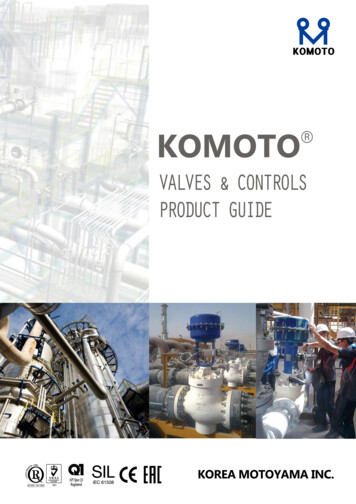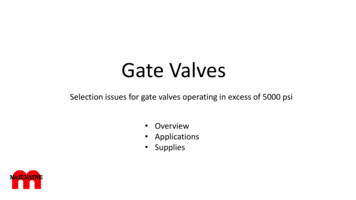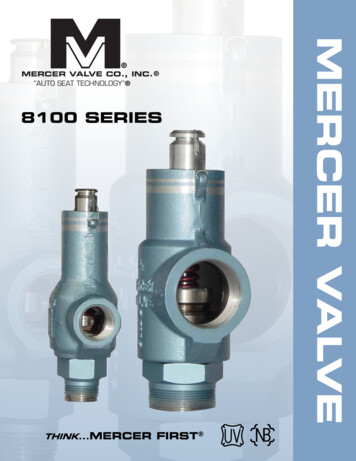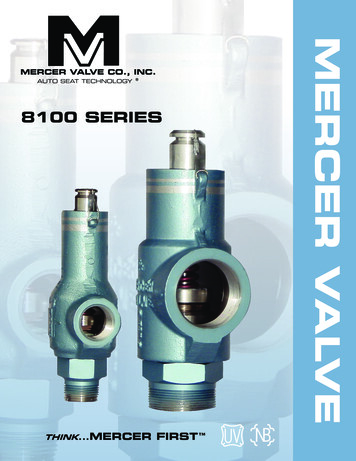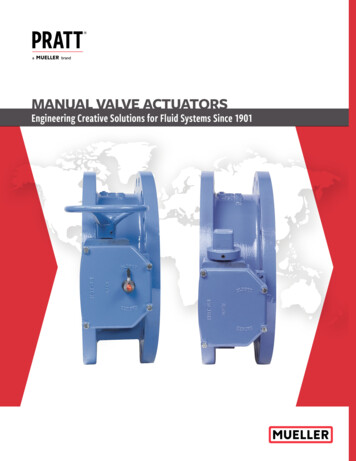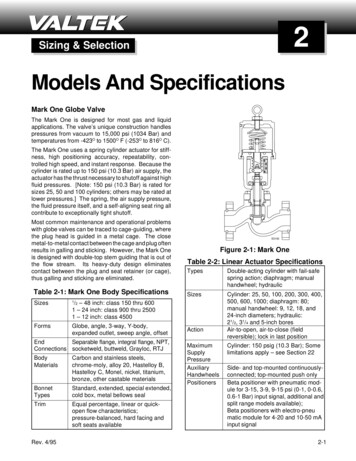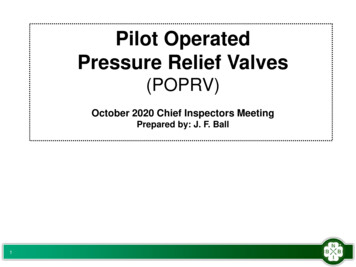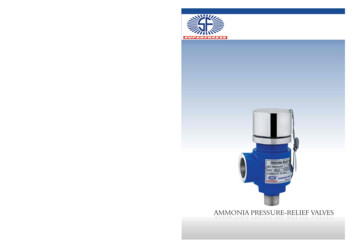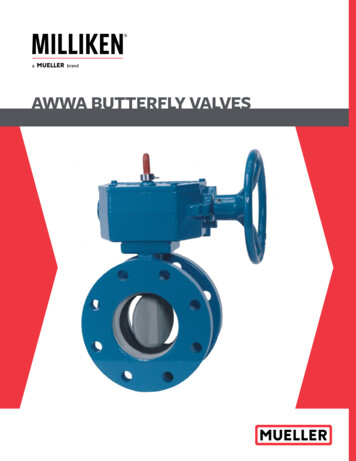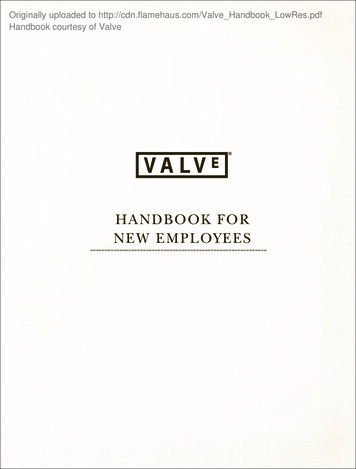
Transcription
Originally uploaded to http://cdn.flamehaus.com/Valve Handbook LowRes.pdfHandbook courtesy of ValveHANDBOOK F O RNE W E MPL OYEES
HAN DB O OK FO RN E W E MPL OYE E S A fearless adventurein knowing what to dowhen no one’s theretelling you what to doFIRST EDITION2012
Table of ContentsPreface . . . . . . . . . . . . . . . . . . . . . . . . . . . . . . . . . . . . . . . . . . . . . . . . . . . . . . viiHow to Use This Book . . . . . . . . . . . . . . . . . . . . . . . . . . . . . . . . . . . . . . . . . viiiPart 1: Welcome to Valve . . . . . . . . . . . . . . . . . . . . . . . . . . . . . . . . . . . . . . . . 1Your First DayValve Facts That MatterWelcome to FlatlandPart 2: Settling In . . . . . . . . . . . . . . . . . . . . . . . . . . . . . . . . . . . . . . . . . . . . . . . . . . . . 7Dedicated to the familiesof all Valve employees.Thank you for helping us makesuch an incredible place.Your First MonthWhat to Work OnWhy do I need to pick my own projects?, But how do I decide which things towork on?, How do I find out what projects are under way?, Short-term vs. long term goals, What about all the things that I’m not getting done?, How doesValve decide what to work on? Can I be included the next time Valve isdeciding X?Teams, Hours, and the OfficeCabals, Team leads, Structure happens, Hours, The officeRisksWhat if I screw up?, But what if we ALL screw up?Part 3: How Am I Doing? . . . . . . . . . . . . . . . . . . . . . . . . . . . . . . . . . . . . . . . . . . . . 25Your Peers and Your PerformancePeer reviews, Stack ranking (and compensation)Part 4: Choose Your Own Adventure . . . . . . . . . . . . . . . . . . . . . . . . . . . . . . . . . . 35Your First Six MonthsRoles, Advancement vs. growth, Putting more tools in your toolboxPart 5: Valve Is Growing . . . . . . . . . . . . . . . . . . . . . . . . . . . . . . . . . . . . . . . . . . . . . . 41Your Most Important RoleHiring, Why is hiring well so important at Valve?, How do we choosethe right people to hire?, We value “T-shaped” people, We’re lookingfor people stronger than ourselves, Hiring is fundamentally the sameacross all disciplinesPart 6: Epilogue . . . . . . . . . . . . . . . . . . . . . . . . . . . . . . . . . . . . . . . . . . . . . . . . . . . . . 51What Is Valve Not Good At?What Happens When All This Stuff Doesn’t Work?Where Will You Take Us?Glossary . . . . . . . . . . . . . . . . . . . . . . . . . . . . . . . . . . . . . . . . . . . . . . . . . . . . . . . . . . . . 55
PrefaceIn 1996, we set out to make great games, but we knew backthen that we had to first create a place that was designedto foster that greatness. A place where incredibly talentedindividuals are empowered to put their best work into thehands of millions of people, with very little in their way.This book is an abbreviated encapsulation of our guidingprinciples. As Valve continues to grow, we hope that theseprinciples will serve each new person joining our ranks.If you are new to Valve, welcome. Although the goals inthis book are important, it’s really your ideas, talent, andenergy that will keep Valve shining in the years ahead.Thanks for being here. Let’s make great things. 2012 Valve Corporation. All Rights Reserved. Printed in the United States of America.This handbook does not constitute an employment contract or binding policy and is subjectto change at any time. Either Valve or an employee can terminate the employment relationshipat any time, with or without cause, with or without notice. Employment with Valve is at-will,and nothing in this handbook will alter that status.First edition: March 2012Valve CorporationBellevue, Washington USAwww.valvesoftware.comDesigned by ValveTypeface: ITC New Baskerville10 9 8 7 6 5 4 3 2 1– vii –
VALVE: H ANDBO O K FO R NEW EMP LO YEE sHow to Use This BookThis book isn’t about fringe benefits or how to set up yourworkstation or where to find source code. Valve works inways that might seem counterintuitive at first. This handbook is about the choices you’re going to be making andhow to think about them. Mainly, it’s about how not tofreak out now that you’re here. For more nuts-and-bolts information, there’s an official Valve intranet(http://intranet). Look for stuff there like how to build a Steamdepot or whether eyeglasses are covered by your Flex Spending plan.This book is on the intranet, so you can edit it. Once you’ve read it,help us make it better for other new people. Suggest new sections,or change the existing ones. Add to the Glossary. Or if you’re notall that comfortable editing it, annotate it: make comments andsuggestions. We’ll collectively review the changes and fold theminto future revisions. – viii –1Welcome to Valve
VALVE: H ANDBO O K FO R NEW EMP LO YEE sYour First DayW E L CO M E TO VALV EValve Facts That MatterFig. 1-2Fig. 1-1So you’ve gone through the interview process, you’vesigned the contracts, and you’re finally here at Valve.Congratulations, and welcome.Valve has an incredibly unique way of doing thingsthat will make this the greatest professional experienceof your life, but it can take some getting used to. Thisbook was written by people who’ve been where you arenow, and who want to make your first few months hereas easy as possible.–2–Valve is self-funded. We haven’t ever brought in outsidefinancing. Since our earliest days this has been incrediblyimportant in providing freedom to shape the companyand its business practices.Valve owns its intellectual property. This is far from thenorm, in our industry or at most entertainment contentproducing companies. We didn’t always own it all. Butthanks to some legal wrangling with our first publisherafter Half-Life shipped, we now do. This has freed us tomake our own decisions about our products.Valve is more than a game company. We started ourexistence as a pretty traditional game company. Andwe’re still one, but with a hugely expanded focus. Whichis great, because we get to make better games as a result,–3–
VALVE: H ANDBO O K FO R NEW EMP LO YEESand we’ve also been able to diversify. We’re an entertainment company. A software company. A platform company.But mostly, a company full of passionate people who lovethe products we create.Welcome to FlatlandFig. 1-3Hierarchy is great for maintaining predictability andrepeatability. It simplifies planning and makes it easier tocontrol a large group of people from the top down, whichis why military organizations rely on it so heavily.But when you’re an entertainment company that’s spentthe last decade going out of its way to recruit the mostintelligent, innovative, talented people on Earth, tellingthem to sit at a desk and do what they’re told obliterates99 percent of their value. We want innovators, and thatmeans maintaining an environment where they’ll flourish.That’s why Valve is flat. It’s our shorthand way of sayingthat we don’t have any management, and nobody “reportsto” anybody else. We do have a founder/president, buteven he isn’t your manager. This company is yours tosteer—toward opportunities and away from risks. You havethe power to green-light projects. You have the power toship products.A flat structure removes every organizational barrier–4–
VALVE: H ANDBO O K FO R NEW EMP LO YEE sbetween your work and the customer enjoying that work.Every company will tell you that “the customer is boss,” buthere that statement has weight. There’s no red tape stopping you from figuring out for yourself what our customerswant, and then giving it to them.If you’re thinking to yourself, “Wow, that sounds like alot of responsibility,” you’re right. And that’s why hiring isthe single most important thing you will ever do at Valve(see “Hiring ,” on page 43). Any time you interview a potentialhire, you need to ask yourself not only if they’re talented orcollaborative but also if they’re capable of literally runningthis company, because they will be.2 Why does your desk have wheels? Think of those wheels as a symbolicreminder that you should always be considering where you could moveyourself to be more valuable. But also think of those wheels as literalwheels, because that’s what they are, and you’ll be able to actually moveyour desk with them.You’ll notice people moving frequently; often whole teams will movetheir desks to be closer to each other. There is no organizationalstructure keeping you from being in close proximity to the peoplewho you’d help or be helped by most.The fact that everyone is always moving around within the companymakes people hard to find. That’s why we have http://user—check itout. We know where you are based on where your machine is pluggedin, so use this site to see a map of where everyone is right now. –6–Settling In
VALVE: H ANDBO O K FO R NEW EMP LO YEE sYour First MonthSo you’ve decided where you put your desk. You knowwhere the coffee machine is. You’re even pretty sure youknow what that one guy’s name is. You’re not freakingout anymore. In fact, you’re ready to show up to work thismorning, sharpen those pencils, turn on your computer,and then what?This next section walks you through figuring out what towork on. You’ll learn about how projects work, how cabalswork, and how products get out the door at Valve.What to Work OnWhy do I need to pick my own projects?We’ve heard that other companies have people allocate apercentage of their time to self-directed projects. At Valve,that percentage is 100.Since Valve is flat, people don’t join projects becausethey’re told to. Instead, you’ll decide what to work onafter asking yourself the right questions (more on thatlater). Employees vote on projects with their feet (or deskwheels). Strong projects are ones in which people cansee demonstrated value; they staff up easily. This meansthere are any number of internal recruiting effortsconstantly under way.–8–S ettling inIf you’re working here, that means you’re good at yourjob. People are going to want you to work with them ontheir projects, and they’ll try hard to get you to do so. Butthe decision is going to be up to you. (In fact, at timesyou’re going to wish for the luxury of having just oneperson telling you what they think you should do, ratherthan hundreds.)But how do I decide which things to work on?Deciding what to work on can be the hardest part of yourjob at Valve. This is because, as you’ve found out by now,you were not hired to fill a specific job description. Youwere hired to constantly be looking around for the mostvaluable work you could be doing. At the end of a project,you may end up well outside what you thought was yourcore area of expertise.There’s no rule book for choosing a project or task atValve. But it’s useful to answer questions like these: Of all the projects currently under way, what’s themost valuable thing I can be working on? Which project will have the highest direct impacton our customers? How much will the work I shipbenefit them? Is Valve not doing something that it should be doing? What’s interesting? What’s rewarding? What leveragesmy individual strengths the most?–9–
VALVE: H ANDBO O K FO R NEW EMP LO YEE sHow do I find out what projects are under way?There are lists of stuff, like current projects, but by farthe best way to find out is to ask people. Anyone, really.When you do, you’ll find out what’s going on around thecompany and your peers will also find out about you. Lotsof people at Valve want and need to know what you careabout, what you’re good at, what you’re worried about,what you’ve got experience with, and so on. And the wayto get the word out is to start telling people all of thosethings. So, while you’re getting the lay of the land bylearning about projects, you’re also broadcasting yourown status to a relevant group of people.Got an idea for how Valve could change how we internallybroadcast project/company status? Great. Do it. In themeantime, the chair next to anyone’s desk is always open,so plant yourself in it often.S ettling inproblem or a threat, and it’s one with a clear cost, it’s hardnot to address it immediately.This sounds like a good thing, and it often is, but it hassome downsides that are worth keeping in mind. Specifically, if we’re not careful, these traits can cause us to raceback and forth between short-term opportunities andthreats, being responsive rather than proactive.So our lack of a traditional structure comes with animportant responsibility. It’s up to all of us to spend effortfocusing on what we think the long-term goals of the company should be.Someone told me to (or not to) work on X. Andthey’ve been here a long time!Because we all are responsible for prioritizing our ownwork, and because we are conscientious and anxious to bevaluable, as individuals we tend to gravitate toward projectsthat have a high, measurable, and predictable return forthe company. So when there’s a clear opportunity on thetable to succeed at a near-term business goal with a clearreturn, we all want to take it. And, when we’re faced with aWell, the correct response to this is to keep thinking aboutwhether or not your colleagues are right. Broaden theconversation. Hold on to your goals if you’re convincedthey’re correct. Check your assumptions. Pull more peoplein. Listen. Don’t believe that anyone holds authority overthe decision you’re trying to make. They don’t; but theyprobably have valuable experience to draw from, or information/data that you don’t have, or insight that’s new.When considering the outcome, don’t believe that anyonebut you is the “stakeholder”. You’re it. And Valve’s customers are who you’re serving. Do what’s right for them.– 10 –– 11 –Short-term vs. long-term goals
VALVE: H ANDBO O K FO R NEW EMP LO YEE s There are lots of stories about how Gabe has made important decisionsby himself, e.g., hiring the whole Portal 1 team on the spot after onlyhalf of a meeting. Although there are examples, like that one, wherethis kind of decision making has been successful, it’s not the norm forValve. If it were, we’d be only as smart as Gabe or management types,and they’d make our important decisions for us. Gabe is the first to saythat he can’t be right nearly often enough for us to operate that way.His decisions and requests are subject to just as much scrutiny andskepticism as anyone else’s. (So if he tells you to put a favorite customknife design into Counter-Strike, you can just say no.) Whatever group you’re in, whether you’re building Steamservers, translating support articles, or making the tenthousandth hat for Team Fortress 2, this applies to you. It’scrucial that you believe it, so we’ll repeat it a few moretimes in this book.What about all the things that I’m not getting done?It’s natural in this kind of environment to constantly feellike you’re failing because for every one task you decideto work on, there will be dozens that aren’t getting yourattention. Trust us, this is normal. Nobody expects youto devote time to every opportunity that comes your way.Instead, we want you to learn how to choose the mostimportant work to do.– 12 –S ettling inHow does Valve decide what to work on?The same way we make other decisions: by waiting forsomeone to decide that it’s the right thing to do, and thenletting them recruit other people to work on it with them.We believe in each other to make these decisions, and thisfaith has proven to be well-founded over and over again.But rather than simply trusting each other to just besmart, we also constantly test our own decisions. Wheneverwe move into unknown territory, our findings defy our ownpredictions far more often than we would like to admit.We’ve found it vitally important to, whenever possible,not operate by using assumptions, unproven theories, orfolk wisdom.This kind of testing takes place across our business, fromgame development to hiring, to selling games on Steam.Luckily, Steam is a fantastic platform for business learning. It exists to be an entertainment/service platform forour customers, and as such it also is a conduit for constantcommunication between us and them.Accepted truisms about sales, marketing, regionality, seasonality, the Internet, purchasing behavior, game design,economics, and recruiting, etc., have proven wrong surprisingly often. So we have learned that when we take nearlyany action, it’s best to do so in a way that we can measure,predict outcomes, and analyze results.– 13 –
VALVE: H ANDBO O K FO R NEW EMP LO YEE sRecruiting can be a difficult process to instrument andmeasure. Although we have always tried to be highly rational about how we hire people, we’ve found much roomfor improvement in our approach over the years. We havemade significant strides toward bringing more predictability, measurement, and analysis to recruiting. A processthat many assume must be treated only as a “soft” artbecause it has to do with humans, personalities, language,and nuance, actually has ample room for a healthy doseof science. We’re not turning the whole thing over torobots just yet though(see “Hiring ,” on page 43).S ettling inTeams, Hours, and the OfficeCabalsCan I be included the next time Valve is deciding X?Yes. There’s no secret decision-making cabal. No matterwhat project, you’re already invited. All you have to do iseither (1) Start working on it, or (2) Start talking to all thepeople who you think might be working on it already andfind out how to best be valuable. You will be welcomed—there is no approval process or red tape involved. Quite theopposite—it’s your job to insert yourself wherever you thinkyou should be.Fig. 2-1Cabals are really just multidisciplinary project teams. We’veself-organized into these largely temporary groups sincethe early days of Valve. They exist to get a product or largefeature shipped. Like any other group or effort at thecompany, they form organically. People decide to join thegroup based on their own belief that the group’s work isimportant enough for them to work on. For reference, read the article on cabals by Ken Birdwell. It describeswhere cabals came from and what they meant to us early on:http://tinyurl.com/ygam86p. – 14 –– 15 –
VALVE: H ANDBO O K FO R NEW EMP LO YEE sTeam leadsOften, someone will emerge as the “lead” for a project.This person’s role is not a traditional managerial one.Most often, they’re primarily a clearinghouse of information. They’re keeping the whole project in their head atonce so that people can use them as a resource to checkdecisions against. The leads serve the team, while actingas centers for the teams.Structure happensProject teams often have an internal structure that formstemporarily to suit the group’s needs. Although people atValve don’t have fixed job descriptions or limitations onthe scope of their responsibility, they can and often dohave clarity around the definition of their “job” on anygiven day. They, along with their peers, effectively create ajob description that fits the group’s goals. That descriptionchanges as requirements change, but the temporary structure provides a shared understanding of what to expectfrom each other. If someone moves to a different group ora team shifts its priorities, each person can take on a completely different role according to the new requirements.Valve is not averse to all organizational structure—itcrops up in many forms all the time, temporarily. Butproblems show up when hierarchy or codified divisions ofS ettling inlabor either haven’t been created by the group’s membersor when those structures persist for long periods of time.We believe those structures inevitably begin to serve theirown needs rather than those of Valve’s customers. Thehierarchy will begin to reinforce its own structure by hiringpeople who fit its shape, adding people to fill subordinatesupport roles. Its members are also incented to engage inrent-seeking behaviors that take advantage of the powerstructure rather than focusing on simply delivering valueto customers.HoursWhile people occasionally choose to push themselves towork some extra hours at times when something big isgoing out the door, for the most part working overtime forextended periods indicates a fundamental failure in planning or communication. If this happens at Valve, it’s a signthat something needs to be reevaluated and corrected. Ifyou’re looking around wondering why people aren’t in“crunch mode,” the answer’s pretty simple. The thing wework hardest at is hiring good people, so we want them tostick around and have a good balance between work andfamily and the rest of the important stuff in life.If you find yourself working long hours, or just generallyfeel like that balance is out of whack, be sure to raise the(cont’d on page 19)– 16 –– 17 –
A Timeline of Valve’s HistoryFig. 2-2Method to move your desk199619971.2.3.4.Valve is formed in Kirkland, WA,by Gabe Newell and Mike Harrington.Gabe promises that if HL becomesthe #1- selling game, the companywill take everyone on vacation.Formation papers are signed on thesame day as Gabe’s wedding.After internal review, HL deemednot good enough to ship.HL team returns to the drawing boardand essentially starts over.Quake engine license is acquiredfrom id Software.Production commences on the gamesoon to be known as Half-Life (HL).step 1.step 2.step 3.step 4.Unplug cords from wallMove your deskPlug cords back into wallGet back to workVA LV E ME THOD D IA G . 1Prospero permanently shelved.Production commences on Valve’ssecond game, Prospero.Valve recruits and hires two gameteams, including the first internationalemployee from the UK.– 19 –H F N E :96:97::01 V A LV E
19 9 8Half-Life: Day One OEM demo is released.Released as a demo bundled with theVoodoo Banshee graphics card, the OEMrelease circulates far beyond its originalintended audience. Valve realizes the levelof anticipation for the full game.Half-Life is released.Following a certain Black Mesa Incident,the world is never the same again.TeamFortress Software Pty. Ltd. is acquired.Creators of Team Fortress (TF) join Valve and commence workon Team Fortress Classic.Valve’s first company vacation to Cabo San Lucas, Mexico.# of employees: 30# of children: 0V A LV E HF NE:9 8 ::0 2199920002001Valve establishes a patternof supporting the bestmods and occasionallyacquiring them.Mike Harrington amicablydissolves his partnershipwith Gabe Newell, leavingNewell as the sole head ofValve Corporation.Half-Life: Opposing Forceis released.Counter-Strike (CS)is released.CS soon becomes theworld’s #1 premier onlineaction game.Ricochet is released.Half-Life: DeathmatchClassic is released.Expansion pack followsevents in Black Mesafrom the viewpoint ofan invading soldier.Team Fortress Classicis released.Robin Walker demonstratesto the mod community howa game can be createdquickly and easily withValve’s SDK.Half-Life: Blue Shiftis released.H F N E :99:00:01::03 V A LV E
2004Source engine is unveiled.20022003Half-Life 2 (HL2) source codeis stolen.A thief infiltrates Valve’s network tosteal and disperse the code base forthe still-in-production HL2.Valve outgrows its original Kirklandoffice space and moves to downtown Bellevue, WA.Steam is announced at GDC.Years of speculation regarding theBorealis and Kraken Base begin Steam is released.Half-Life 2 (HL2) is released.The world’s first (legal) look at the Source engine,along with the game it powers: HL2.HL2 appears as the first game available boththrough Steam and in retail locations.HL2 also becomes Valve’ssecond Xbox title.Counter-Strike: Source (CSS) is released.Years of work on Valve’s new Source enginetechnology finally come to light.Valve’s Steam offers to third parties itsnew suite of tools and services, whichit had originally built to service its owngames like HL and CS.Counter-Strike: Condition Zerois released.CS is released as Valve’s first Xbox title.Valve Anti-Cheat (VAC) is released.In a field where rampant online cheatingruins the experience for many customers,Valve aggressively addresses the issue.V A LV E HF NE:0 2 :03::04Day of Defeat is released.A popular mod gets full Valve support,becoming one of its stalwart products.Half-Life: Source is released.The original HL gets a visual upgrade.H F N E :04::05 V A LV E
200820072005First third-party games arereleased on Steam.A landmark in digitaldistribution, Steamgives PC developersan alternative to retailfor their games.2006Half-Life 2: Episode Oneis released.Valve’s first experiment inepisodic storytelling.2009LEFT 4 DEAD 2is released.Left 4 Dead is released.Presale numbers arethe biggest yet for aValve game.Steam ships its first downloadablecontent update for indie gameThe Maw.The Orange Box is releasedwith two previously-releasedtitles and three new products:Steamworks is unveiled, making thebusiness and technical tools of theSteam platform available to thirdparty developers free of charge.Steam Cloud is released, offeringseamless online storage of any filetypes, including saved games,configuration files, etc.Steam hits over 20 million usersand over 500 games.Half-Life 2: Lost Coasttech demo is released.Team Fortress 2 (TF2), thelong-awaited sequel to theclassic multiplayer game.Supported by the firstversion of Valve’s populardeveloper commentary.Half Life 2: Episode Two—raising the bar for emotionalstorytelling.Portal—hailed worldwide asan instant classic.Day of Defeat: Sourceis released.Valve hires six studentsfrom DigiPen Institute ofTechnology after seeingtheir demo of the game,Narbacular Drop.V A LV E HF NE:0 5 :06:0 7 ::0 6Half-Life Deathmatch:Source is released.Steam Community is releasedwith the first wave of featuresdesigned to help friendsconnect and socialize viathe Steam platform.TF2 gets major class updates for Medic,Pyro, and Heavy characters.These updates are delivered via Steamto all TF2 customers.Steam hits over 25 million usersand over 1,000 games.TF2 releases The Sniper vs Spy Update,followed by outright WAR!After this release, the TF2 updates increase rapidly: more than 280have shipped in total.TF2 ships its first hat.Steam reaches 15 millionactive users, playing over200 games.H F N E :08:09::07 V A LV E
S ettling inissue with whomever you feel would help. Dina loves to forcepeople to take vacations, so you can make her your first stop.The office201020112012Portal 2 debuts on multipleplatforms to critical acclaim.Valve’s 44th international hireclears immigration—this timefrom Germany.Dota 2 premieres atGamescom in Cologne,Germany, with thefirst annual Dota 2championship.In 2012, Valve heads to theBig Island of Hawaii for its10th company vacation.# of employees: 293# of children: 185Valve moves to a moreexpansive location inBellevue, WA.Valve announces thatSteam and Source will beavailable for Macintosh.Valve announces Portal 2is launching in 2011.Sometimes things around the office can seem a little toogood to be true. If you find yourself walking down thehall one morning with a bowl of fresh fruit and Stumptown-roasted espresso, dropping off your laundry to bewashed, and heading into one of the massage rooms, don’tfreak out. All these things are here for you to actually use.And don’t worry that somebody’s going to judge you fortaking advantage of it—relax! And if you stop on the wayback from your massage to play darts or work out in theValve gym or whatever, it’s not a sign that this place is goingto come crumbling down like some 1999-era dot-com startup. If we ever institute caviar-catered lunches, though, thenmaybe something’s wrong. Definitely panic if there’s caviar.Q1: New employee handbookrolls off press.Valve begins developmentof Dota 2.What’s next? You tell us V A LV E HF NE:10:1 1 :12::08– 19 –
VALVE: H ANDBO O K FO R NEW EMP LO YEE sS ettling inRisksWhat if I screw up?Nobody has ever been fired at Valve for making a mistake.It wouldn’t make sense for us to operate that way. Providingthe freedom to fail is an important trait of the company—we couldn’t expect so much of individuals if we also penalized people for errors. Even expensive mistakes, or oneswhich result in a very public failure, are genuinely looked atas opportunities to learn. We can always repair the mistakeor make up for it.Screwing up is a great way to find out that your assumptions were wrong or that your model of the world was alittle bit off. As long as you update your model and moveforward with a better picture, you’re doing it right. Lookfor ways to test your beliefs. Never be afraid to run an experiment or to collect more data.It helps to make predictions and anticipate nasty outcomes. Ask yourself “what would I expect to see if I’mright?” Ask yourself “what would I expect to see if I’mwrong?” Then ask yourself “what do I see?” If somethingtotally unexpected happens, try to figure out why.There are still some bad ways to fail. Repeating the samemistake over and over is one. Not listening to customers orpeers before or after a failure is another. Never ignore theevidence; particularly when it says you’re wrong.– 20 –Fig. 2-3– 21 –
S ettling inFig. 2-4Methods to find out what’s going on1.But what if we ALL screw up?2.Fig. 2-53.step 1.step 2.step 3.step 4.4.Talk to someone in a meetingTalk to someone in the elevatorTalk to someone in the kitchenTalk to someone in the bathroomVA LV E ME THOD D IA G . 2So if every employee is autonomously making his orher own decisions, how is that not chaos? How doesValve make sure that the company is heading in theright direction? When everyone is sharing the steeringwheel, it seems natural to fear that one of us is goingto veer Valve’s car off the road.Ov
This handbook does not constitute an employment contract or binding policy and is subject to change at any time. Either Valve or an employee can terminate the employment relationship at any time, with or without cause, with or without notice. Employment with Valve is at-will, and nothing in this handbook will alter that status.
